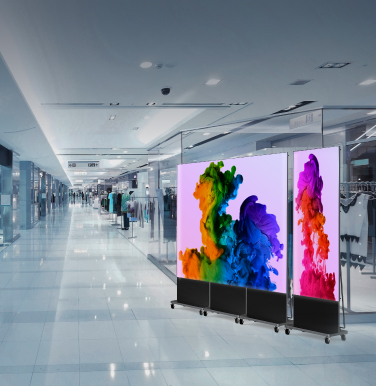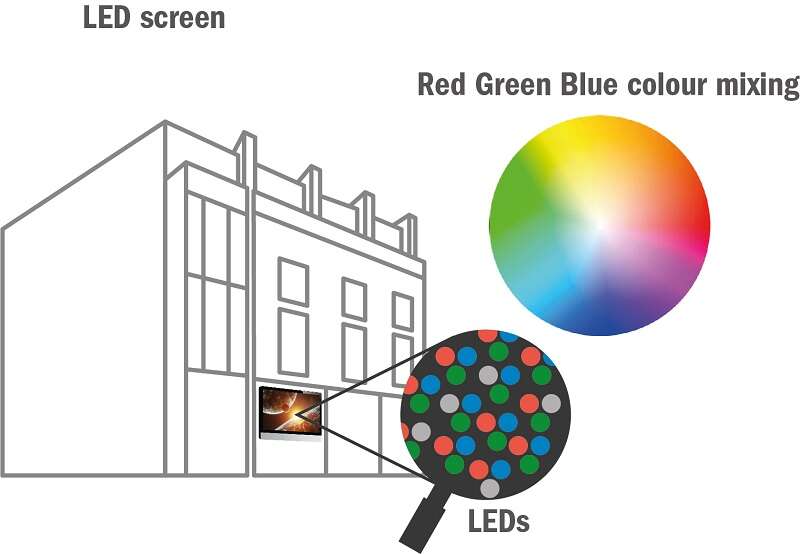Great News For Deciding On Smd Screens
Wiki Article
What Are The Most Crucial Aspects To Take Into Consideration When Selecting The Best Led Display?
When it comes to researching LED displays, resolution and pixel size are very important. Both of these factors directly impact the clarity, the quality, and the overall appearance that the display provides. These two aspects are essential due to a variety of reasons.
1. Image Quality
Pixel Pitch Pixel pitch is defined as the distance that lies between the center of one LED's pixel and the center of the next. A smaller pitch signifies that the LEDs are having a closer space, which results in a greater resolution. This produces clearer, more detailed images.
Resolution: Resolution refers to the total number of pixels that the display has usually expressed in the form of width x height (e.g. 1920x1080). A higher resolution permits more detail to be displayed and creates an immersive experience. This is especially important when you have large screens where the user is near the screen.
2. Distance to view
Pixel pitch plays a major influence on the distance of viewing. A smaller size of pixel (and therefore a higher resolution) are essential for displays that can only be seen from a close distance. This is the case for indoor screens, those employed in retail or exhibitions. A bigger pixel size might suffice for large outdoor displays or billboards that are observed from afar.
3. Content Versatility
Displays with higher resolutions as well as smaller pixels are capable of displaying more content types. From high-definition HD video to tiny graphics and intricate text they're capable of handling a wide variety of formats. This versatility is vital for applications requiring high-quality content like broadcasting studios, digital signage or control rooms.
4. Cost Impacts
Yes, smaller pixels will produce a higher quality image however, the cost to make the display will increase significantly. Making screens with a higher resolution is more expensive due to the quantity of LEDs that are used. Take into consideration the use and distance of the screen when trying to balance high resolution with budget.
5. Application Specificity
The importance of resolution or pixel pitch could differ based on the project.
Indoor Displays: A smaller pixels (e.g. 1.2mm to 2.4mm) is often required to attain high resolution when viewing at close distances.
Outdoor Displays - Can feature larger pixels (e.g. an resolution of 4mm-10mm) since they are seen from a greater distance, and high resolution may not be needed.
6. Durability, Longevity, and Upgradability
As technology for display advancements the pixel pitch decreases, allowing for larger resolutions in smaller spaces. If you purchase a screen with a pixel pitch that is optimal will lower the requirement to upgrade it frequently and ensure its efficiency for a long time.
Conclusion:
Display resolution and pixel pitch are key factors that affect the performance of an LCD display. This is particularly important in terms of watching experience and content flexibility. To select the best LED display for your project, budget, and target audience, you should carefully take into account all these aspects. See the top rated creative led displays for site examples including led panel rental, transparent led panel, led screen for outdoor, transparent led screen, led display transparent, led wall panels, led display device, flexible led display screen, transparent led panel, led display rental and more.

When Selecting Led Displays What Is Important Is The Viewing Angle?
When looking into LED displays, the viewing angle is a crucial aspect to consider. This is especially true when it comes to applications that require the display to be viewed from various angles and at different locations. Here are some reasons why the viewing angles is so important:
1. Uniform Image - Quality
Definition: The angle of view for LED displays refers to the maximum angles where the display is seen in a way that provides adequate visual performance, typically in terms of intensity or color consistency. Often, the viewing angle is specified in both horizontal as well as vertical directions.
The greater the angle of view is, the more images will be constant. The brightness and color are not affected when looking at the display from the side, or above/below.
2. Audience Experience
Impact of large venues. In large venues, such as stadiums, concert halls or conference centres, audience members are spread across a vast space. People who sit at angles can experience poor visibility and the quality of an image on the display with limited viewing space will be degraded.
Application An expansive viewing angle will ensure everyone can see the information clearly and clearly. This is crucial when it comes to large-scale installations, or events that draw a large audience positioned around the display.
3. Suitability for Public Spaces
Public Displays: In settings such as shopping malls, transportation hubs, or outdoor advertising, the viewing angle is critical since people are viewing the display from all angles. The display's effectiveness in engaging and attracting people to visit is constrained by a limited viewing angle.
Application: Digital signage in public places can benefit from broad viewing angle that can increase the reach of the display and make the content more visible and attractive.
4. Content Consistency
Color and Brightness Uniformity: A display that has poor viewing angles may show color shifting or brightness loss when viewing from angles other than the center. This issue can be especially problematic for brand-related content in which accuracy of color is essential.
Application: For areas where brand image or consistency of color is crucial like retail displays and corporate environments, the wide viewing angle helps to ensure that the display's intended appearance remains consistent across viewing angles.
5. Installation Flexibility
Flexibility when installing: A display with a large viewing area allows for more flexibility. It allows for creative placement such as wrapping around columns, or placing it in areas where viewers are coming from different directions.
Application Displays using LEDs that are architectural or creative such as those that are that are used in galleries, museums, or other immersive experiences The large viewing angles can allow for more innovative design without compromising viewer experience.
6. Performance in Rental and Staging
Event Settings - For rental applications and stage settings, where displays can be installed in different locations and settings, a broad view angle is essential to ensure that the display will perform consistently in every setting regardless of location for the audience.
Application A wide viewing angle is perfect for occasions, concerts or trade shows where the attendees may move about or the exhibit will be seen at different angles. This will ensure that all guests get a clear view of the contents.
7. Impact on ROI
Maximizing Visual Impact: A wide-angle display can attract a wider audience, which increases its impact and return on investment. This is particularly important when it comes to advertising screens or informational displays where maximising visibility is vital to get desired results.
Application: In a commercial installation, increasing engagement by ensuring the display's visibility from multiple angles could increase the effectiveness of displayed content.
Conclusion:
The viewing angle is directly influenced by the overall effectiveness, visibility and consistency of LED displays. It is crucial in environments in which there are a lot of users, as the display may be viewed from different angles or where consistency in content is crucial. When evaluating LED displays a wide viewing angle should be prioritized to ensure that the display will meet the requirements of the specific use case and provides a high-quality viewing experience for all users. Take a look at the top led rental screen for more advice including led rental screen, led display screen, transparent display monitor, led wall panels, advertising tvs, led panels, rental led display screen, transparent screen monitor, transparent led display screen, transparent screen and more.

How Important Is Color Accuracy And Calibration When Researching Led Displays?
The precision of color in LED displays is vitally important especially when it comes to applications that focus on the integrity of brands and quality of visuals. The reason these aspects are crucial:
1. Visual Quality and Realism
Color Accuracy is the accuracy of an LED display in reproducing the colors desired by the creators of content. High precision in color ensures that photos and videos look vibrant, realistic and look like they ought to.
Importance : For applications such as advertising broadcasting professional presentations or retail displays precise color reproduction is essential to maintain the impact of the content as well as effectively communicating the intended message.
2. Brand Integrity
Consistency is key to branding. Businesses that use specific color schemes rely on accuracy in color. If the colors aren't correct this could harm the brand identity.
Application: Keeping the brand's colours accurately in retail displays, corporate settings and advertising is crucial for consistency in brand representation across all platforms and media.
3. Engagement and Impact on Audience
Improved Viewer Experience: Displays with high-quality color accuracy can provide an immersive and enjoyable experience for the audience. Accurate color helps communicate emotions and messages more effectively. This enhances the overall impact.
Applications: In settings such as museums, entertainment venues, or anywhere that the goal is to evoke emotional responses the accuracy of color can guarantee that the viewers get the best experience.
4. Content Creator Intent
An accurate representation: Designers and designers spend a lot of time creating visuals that use specific color palettes. Their work is presented precisely as intended with an LED display that replicates the exact colors.
Application: For areas like digital arts, photography, or film, where colors play an important role in telling stories and aesthetic appeal, it's important to maintain color accuracy. This is in keeping with the vision of the artist.
5. Calibration of Consistency
Uniformity across Panels : Calibration is utilized to ensure that all panels in an LED display are calibrated in a way that they display the same colors and brightness, which avoids gaps or mismatches. This is crucial, particularly when large-scale displays have many panels.
Regular Maintenance: Even the most accurate displays will lose color accuracy with time. Regular calibration is essential to ensure consistent performance and ensure that the display continues to meet quality standards.
Application: When installing large video walls, video walls outdoors, or multi-panel systems, the need to calibrate is vital for a smooth and uniform look. This is particularly important when it comes to professional installations that are high-profile.
6. The impact of content types
Different Content Needs: Different types of content have different needs for accuracy in color. Displays for medical imaging, for example, require extreme accuracy in order to perform proper diagnostics. An advertising display, on the other hand can be more focused on vividness and saturation.
Application: In fields like medical imaging, retail at the highest level, or design, the capability of calibrating the color settings will ensure that the display meets specific needs for the content shown.
7. Technology and Specifications
Bit Depth, Gamut and Wide Color Gamut: Displays that have a high bit-depth and large color gamut (such as DCI P3 and Rec.2020) offer better color accuracy and can produce a wider variety of colors. 2020 provides better color accuracy. It can also reproduce more colors. It is crucial to understand the specifications of an LCD where precision in color is of high importance.
Advanced Calibration Tool: New LED displays are often equipped with advanced calibration and software tools that allow precise adjustments. This makes sure that the display is accurate for its lifetime.
Application: For businesses where color fidelity is non-negotiable for example, graphic design, film production, and advertising that is high-end, investing in displays with high-quality color accuracy and calibration capabilities is essential.
Conclusion:
Accuracy in color and calibration are critical for ensuring that LED displays deliver top-quality images that conform to the intentions of the creators of content and in line with the brand's standards. A precise color reproduction is essential for any display, regardless of whether it is it is used for entertainment, advertisement, presentations for professionals, or for specialized fields such as medical imaging. It is important to ensure that color accuracy is maintained and calibrating LED displays when researching them, especially in cases where you require exact colors or consistent performance. Read the top flexible led panels for blog advice including flexible led display screen, wall screen, church led wall, led screen panels, led light board, led display screen rental, video wall church, screen led display, transparent screen monitor, tv led wall and more.
